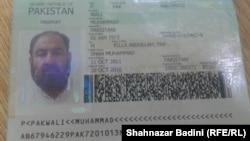Muhammad Afzal (name changed) heard a loud bang on the hot afternoon of May 21 as he waited for a bus near his remote village Killi Sanat Khan in southwestern Pakistan.
“I ran toward the explosion, and in a few minutes I saw a car on fire,” he said of the immediate aftermath of the U.S. drone strike, which is now confirmed to have killed the Taliban leader Mullah Akhtar Muhammad Mansur on a highway connecting the restive Pakistani province of Balochistan to Iran.
“I went to the car and saw there were two people inside. I grabbed one by his burning Kameez (long shirt), and it tore off into my hands. I was unable to remove him on my own,” he said of the initial minutes following the attack, which he says happened between 3 and 4 p.m.
“Soon I was joined by a member of the local Levies (community police) and another person,” he said. “I saw no aircraft, and we thought maybe a gas cylinder inside the car had exploded,” he said. Compressed natural gas cylinders are commonly used to fuel many cars in Pakistan, where they are often blamed for accidents.
Afzal said a crowd of passers-by and villagers soon joined them in trying to put out the blaze by pouring soil over it.
Killi Sanat Khan is nearly halfway on the 630-kilometer road linking Balochistan’s provincial capital, Quetta, to the Taftan border crossing with Iran.
“The shirt I had grabbed from one of the victims had some charred bank notes in one pocket and a [Pakistani] passport and I.D. card in another,” he said.
Hours after a U.S. official announced that Mansur was targeted in a drone strike in Balochistan, photos of the purported Pakistani passport Mansur carried began circulating on Pakistani television stations and online. Since then, many have questioned how the documents survived an attack that burned a car to ashes and killed its occupants.
“We handed over the documents and the bank notes to the local authorities, who arrived nearly an hour after the incident,” Afzal said.
It was not possible to independently verify his claim that the documents were recovered from one of the occupants of the targeted vehicles by other eyewitnesses.
But his version is seconded by Shahnazar Badini, a local journalist and eyewitness. As a stringer for several Pakistani news television channels and newspapers, Badini rushed to the scene from Nushki town, the headquarters of the Balochistan district with the same name where Mansur was targeted.
(Photo Gallery: Aftermath Of The Attack On The Taliban Leader)
“I was told a car had been destroyed mysteriously, which made me curious, so I rushed to the scene,” he told RFE/RL’s Gandhara website. “When I arrived, many people were already there. There were two corpses, and a lot of local villagers, passers-by, and officials.”
Badini is unable to pinpoint the exact time but thinks he reached the scene within two hours of the incident.
“I was told the car was attacked nearly 5 kilometers away from a roadside restaurant where its occupants had stopped to eat lunch,” he said “Some of the people told me the car was targeted from an airplane, but nobody was able to say whether they saw an aircraft drop a bomb or fire a missile.”
Badini took pictures of the scene and later accompanied local authorities to their offices, where he was allowed to take pictures of the documents carried by one of the victims. “We had no idea it was Mullah Mansur. We took pictures of the documents, thinking he was a Pakistani citizen [and this might help him his family identify him].”
Badini also seconded Afzal’s version of how one of the victim’s identity documents were discovered in his half-burnt shirt.
Most versions of how Mansur’s documents were found emphasize that they were recovered near the scene. But Afzal and Badini offer the first eyewitness accounts.
Kiyya Baloch is a freelance journalist who reports on the insurgency, militancy, and sectarian violence in Balochistan.
as/fg







